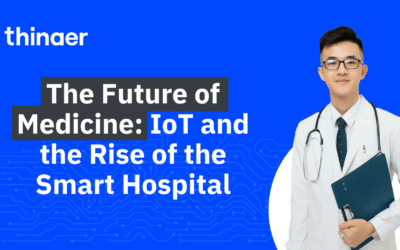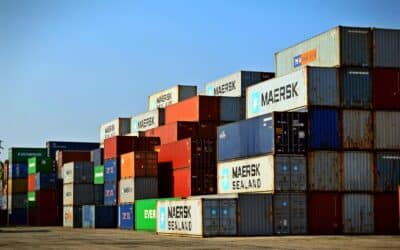Thinaer Blog
Smarter production decisions and AI initiatives
Reflecting on an Award-Winning Year and Looking Ahead to 2025
As the holiday season arrives and 2024 draws to a close, it’s the perfect time to reflect on the past year's accomplishments and share our excitement for the journey ahead. Thinaer has had an extraordinary year, and we’re deeply grateful to our clients, partners, and...
The Future of Defense Manufacturing: Thinaer’s Perspective
The defense manufacturing sector stands at the forefront of technological evolution. As geopolitical dynamics shift and the demand for innovative defense systems accelerates, manufacturers are under increasing pressure to produce more, faster, and better. The future...
IoT Solutions for Manufacturing: 3x Your Factory Productivity with IoT Devices
Key Highlights The manufacturing industry is increasingly using the Internet of Things (IoT). It helps to improve operations, boost productivity, and support data-based decisions. The iot sensors market is expanding rapidly as more companies adopt smart devices. IoT...
Revolutionizing Healthcare with IoT for Transformative Patient Care
Unlock the Potential of IoT in Healthcare for Better Outcomes with Thinaer. Healthcare systems today operate in an environment where every second counts, every resource matters, and every decision carries weight. In the face of growing patient demands, strict...
Optimize Your Business with Asset Management Solutions
Key HighlightsDon’t know where your essential assets are? Asset management software helps you keep track of all your business assets in one place.Are you frustrated with slow manual processes? Our software automates asset tracking, saving you valuable time and...
IIoT and AI: The Synergistic Symphony Transforming Industrial Landscapes
The combination of the Industrial Internet of Things (IIoT) and Artificial Intelligence (AI) is changing how industries operate, making them more efficient, proactive, and data-driven. But it’s not just a small improvement—it’s a game-changer that’s reshaping...
How This Technology is Making Factory Automation Easier
A New Chapter in Manufacturing: Smart Manufacturing and Industry 4.0 Manufacturing is evolving rapidly. Today, we’re entering an era called Industry 4.0, where digital technology and data-driven insights blend directly with traditional production processes to create...
Smart Manufacturing Innovations & Technologies
Key Highlights Smart manufacturing leverages digital technologies to optimize factory operations. Key benefits include improved efficiency, reduced costs, and higher product quality. Core technologies include IIoT, AI, robotics, and cloud computing. Challenges...
Amazon Monitron is Ending: Why Thinaer is Your Perfect IoT Replacement
Best AWS Monitron Replacement: Upgrade Your IoT Strategy with Thinaer as Monitron Winds Down Operations
How IoT Predictive Maintenance Prevents Equipment Failures and Maximizes Efficiency
Imagine you’re running a production line, and out of nowhere, a critical machine grinds to a halt. Or maybe it’s a piece of healthcare equipment that suddenly malfunctions during a busy day at the hospital. Downtime like this can spell disaster, affecting both...
How IoT is Modernizing Defense Industrial Base Manufacturing
In a growing age of digital transformation and manufacturing modernization, Defense Industrial Base (DIB) manufacturers still face operational inefficiencies due to outdated technologies and legacy systems. As the demands on defense contractors grow, there is an...
The Data Frontier: How AI and Digital Twins are Transforming Modern Manufacturing
Data consumption isn't just growing—it's exploding at a rate that boggles the mind. Global data creation surged to 64.2 zettabytes in 2020, driven by increased demand during the COVID-19 pandemic, and is projected to grow to over 180 zettabytes by 2025, while storage...
Thinaer Now Available in the Microsoft Azure Marketplace
Microsoft Azure customers worldwide now gain access to Sonar to take advantage of the scalability, reliability, and agility of Azure to drive application development and shape business strategies.
Aprio and Thinaer Forge Strategic Partnership to Deliver Cutting-Edge IoT Solutions for Manufacturing
Aprio and Thinaer Forge Strategic Partnership to Deliver Cutting-Edge IoT Solutions for Manufacturing Aprio, a leading business advisory and accounting firm, and Thinaer, a pioneer in manufacturing digital transformation, are excited to announce their strategic...
Deploying on Thinaer: A Guide to Successful IoT Implementation
Deploying an IoT project can significantly enhance your business operations, offering unparalleled visibility and control over your assets. At Thinaer, we are dedicated to providing a seamless IoT deployment experience backed by extensive support and resources. This guide will walk you through the steps of onboarding, installing, and utilizing our IoT solutions to ensure your project is a success from start to finish.
The Onboarding Process
Once you decide to move forward with an IoT project, the first step is the onboarding process. Post-sales, we initiate a kick-off call to introduce the customer success team and outline the project. This phase involves:
Installation: We begin with network configuration to ensure seamless connectivity between our software and your networks.
Training: We train your team on both the hardware and our software platform, Sonar.
Support: We provide ongoing support to address any questions or issues that arise.
Feedback: We continuously gather feedback to improve and tailor our support for your project.
Comprehensive Resources and Support
Thinaer offers a robust support system to ensure your IoT deployment goes smoothly. Our resources include:
Help Center: A thorough repository of guides, pictures, and videos to assist with the configuration process.
Live Chat Bot: Accessible through our Help Center, allowing customers to get immediate answers to their questions.
Support Email and Account Manager: Direct access to our support team for personalized assistance.
Practical Deployment Process
At Thinaer, we prioritize simplicity and efficiency in deployment. Our hardware, including the Thinaer gateway and various beacons, is designed for easy installation:
Thinaer Gateway: BLE-enabled, it transmits data from beacons to the cloud and then to our Sonar platform, providing real-time data visibility.
Beacons: Our beacons measure various metrics such as temperature, humidity, and vibration. They transmit this data to the gateway, which then makes it accessible on the Sonar platform.
The deployment process is quick and seamless. For example, our starter kit can be set up in about three minutes per gateway, making it possible to deploy multiple gateways within an hour.
Popular Beacons and Their Uses
Thinaer offers a range of beacons tailored to different needs:
E8 Beacon: Used for asset location tracking, providing real-time visibility of important assets.
E7 Beacon: Measures vibration, helping assess machine utilization and operational status.
S1 Beacon: Tracks temperature and humidity, ideal for controlled environments such as warehouses.
These beacons enable comprehensive monitoring and data collection, enhancing operational efficiency.
Customizing the Onboarding Process
We pride ourselves on being responsive to customer feedback and continuously refining our support resources. For example, we updated our starter kit setup guide to make instructional videos more accessible based on customer suggestions.
Post-Deployment Monitoring and Training
Once the hardware is deployed and configured, we focus on training your team to maximize the benefits of the Sonar platform. Our thorough Sonar training covers every aspect of the software, ensuring your team can effectively monitor and analyze data. Additionally, we provide a library of video tutorials for ongoing reference.
Real-Time Data and Digital Twins
Sonar offers a digital twin of your operations, providing real-time data on asset location, machine utilization, and environmental conditions. This data is updated every three seconds, allowing for precise and timely decision-making.
Ongoing Support and Success Metrics
We set success metrics from the beginning to align our efforts with your goals. Regular touchpoints with customers help us gauge Sonar utilization and ensure continuous improvement and success.
Conclusion
Deploying an IoT project with Thinaer is a streamlined process supported by extensive resources and a dedicated customer success team. From the initial installation to ongoing monitoring and training, we are committed to ensuring your project’s success. Contact us today to learn more about how Thinaer can elevate your operations with innovative IoT solutions.
For more information on IoT innovations and digital transformation, subscribe to our newsletter and download our new eBook, “Leading the Charge,” for comprehensive guidance on your transformation journey.
Find Your Blind Spots
Free 30-Minute Blind Spot Workshop















